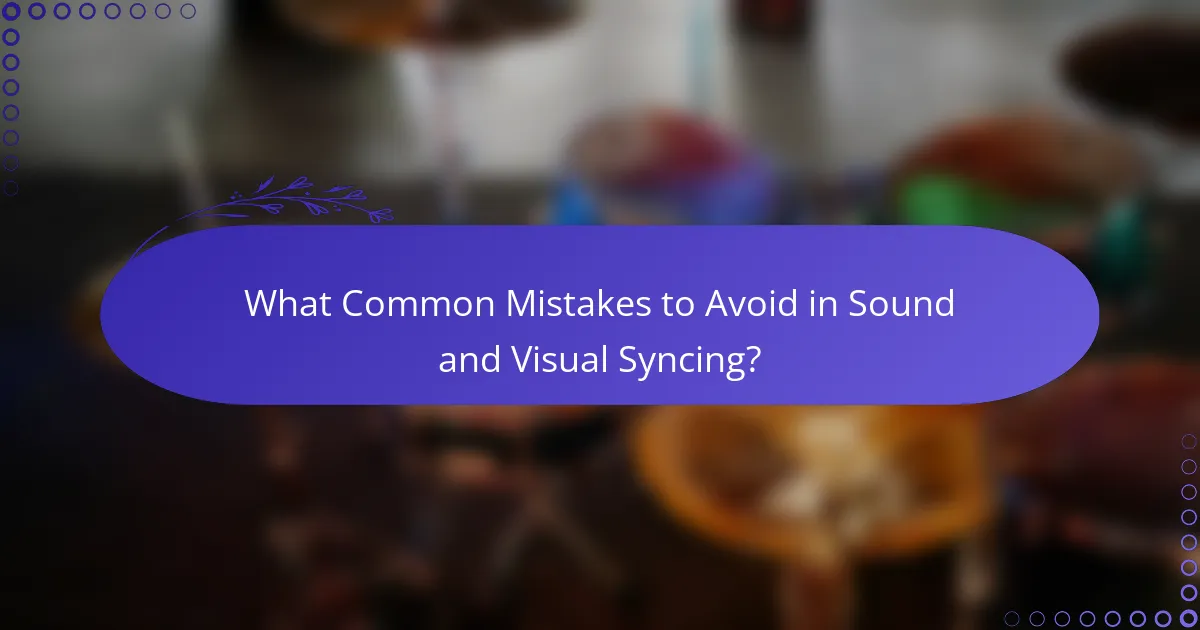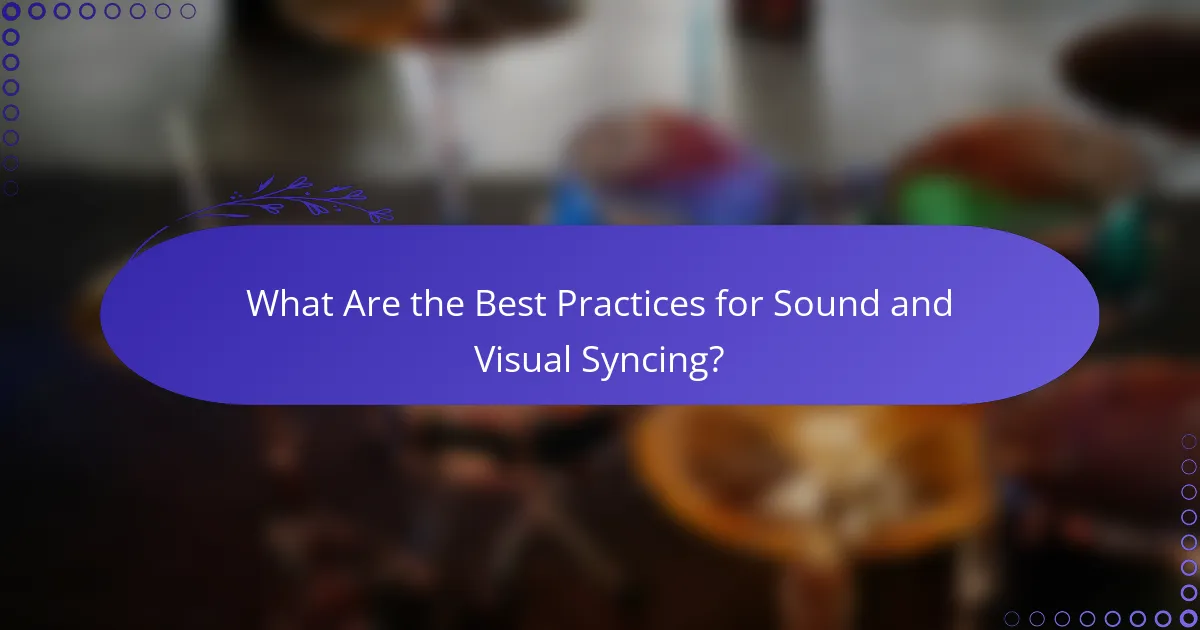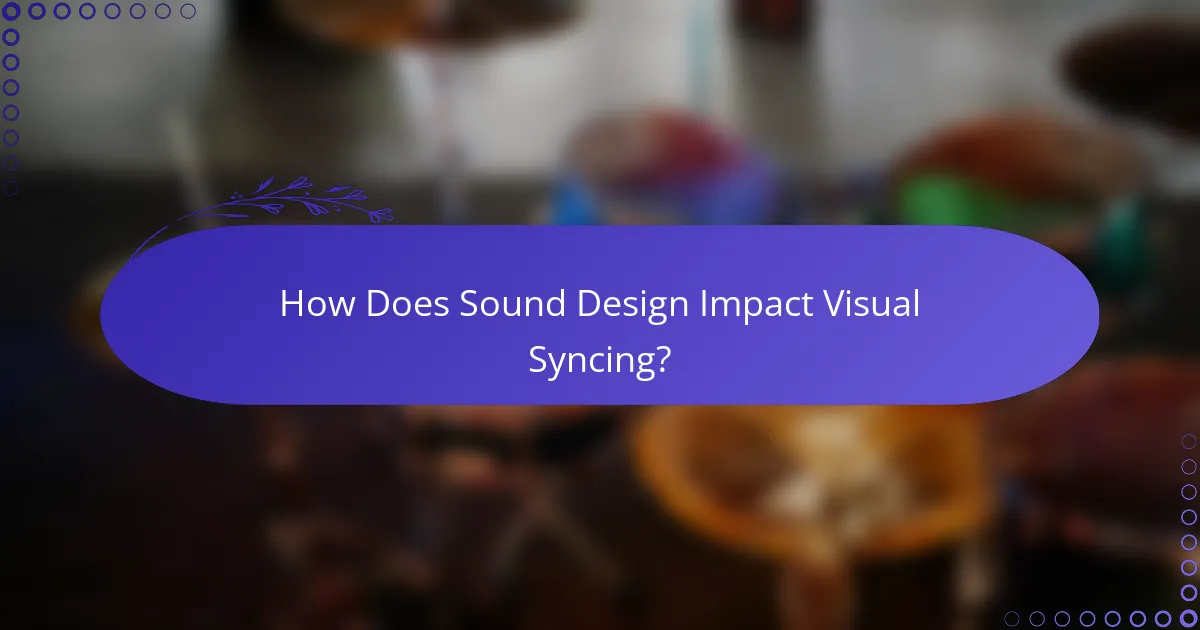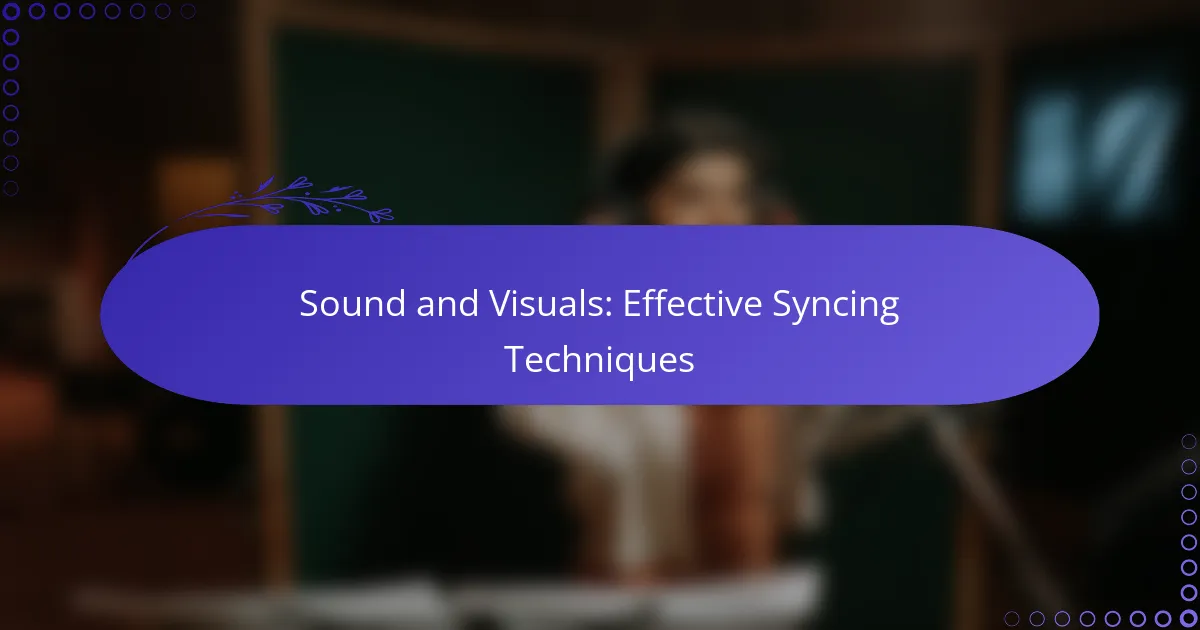Effective syncing of sound and visuals is essential in video production, as it aligns audio tracks with visual elements to create a cohesive viewing experience. This alignment not only enhances storytelling but also increases audience engagement, making it a critical skill for filmmakers and content creators. By utilizing the right tools and avoiding common pitfalls, creators can achieve seamless integration of sound and visuals.

How to Sync Sound and Visuals Effectively?
Effective syncing of sound and visuals involves aligning audio tracks with corresponding visual elements to create a cohesive viewing experience. This process can enhance storytelling and engagement, making it essential for filmmakers, video editors, and content creators.
Using audio timecode
Audio timecode is a numerical reference that helps synchronize sound and visuals accurately. By embedding timecodes in both audio and video files, editors can easily match the two during the editing process.
When using audio timecode, ensure that both your audio and video devices are set to the same frame rate. This minimizes discrepancies and allows for precise alignment, especially in complex projects.
Employing visual cues
Visual cues, such as lip movements or specific actions, can serve as effective markers for syncing sound and visuals. By identifying key moments in the video, editors can align the audio track to these visual indicators.
For example, if a character speaks, the editor should match the audio to the moment their lips start moving. This technique is particularly useful in dialogue-heavy scenes and can significantly enhance the viewer’s experience.
Utilizing software tools
Many video editing software tools offer features specifically designed for syncing sound and visuals. Programs like Adobe Premiere Pro and Final Cut Pro include automatic syncing options that can save time and effort.
When using these tools, familiarize yourself with their syncing capabilities, such as waveform matching or multi-camera syncing. These features can streamline the editing process and improve accuracy.
Implementing manual syncing techniques
Manual syncing techniques involve adjusting audio and video tracks by ear and eye, which can be effective when automatic methods fail. This approach requires careful listening and visual observation to achieve the best results.
To manually sync, start by placing the audio track on the timeline and visually aligning it with the corresponding video. Play back the sequence and make fine adjustments as necessary. This method can be time-consuming but is often necessary for achieving precise synchronization.

What Tools Are Best for Syncing Sound and Visuals?
Effective syncing of sound and visuals is crucial in video production, and several tools excel in this area. The best options include Adobe Premiere Pro, Final Cut Pro, and Avid Media Composer, each offering unique features and workflows to streamline the syncing process.
Adobe Premiere Pro
Adobe Premiere Pro is a widely used video editing software that provides robust tools for syncing audio and video. Its built-in Auto Sync feature allows users to align audio tracks with video clips automatically, saving time during the editing process.
To use this feature, simply select the clips you want to sync, right-click, and choose ‘Merge Clips.’ This method is effective for projects where audio is recorded separately, ensuring a seamless final product. However, be cautious of potential drift in longer recordings, which may require manual adjustments.
Final Cut Pro
Final Cut Pro offers an intuitive interface for syncing sound and visuals, particularly through its synchronization feature. Users can easily sync clips by selecting them and using the ‘Synchronize Clips’ option, which combines audio and video based on waveform analysis.
This software is particularly beneficial for projects with multiple audio sources, as it can handle complex syncing tasks efficiently. Keep in mind that ensuring high-quality audio recordings will improve the accuracy of the syncing process.
Avid Media Composer
Avid Media Composer is a professional-grade editing tool that excels in audio-visual synchronization, especially in film and television production. It provides a powerful ‘Audio Sync’ feature that allows users to align audio tracks with video clips based on timecode or waveform.
For best results, ensure that your audio and video files are properly labeled and organized. This will facilitate a smoother syncing process and minimize the risk of errors. Avid’s robust media management tools can also help in tracking and managing multiple audio sources effectively.

What Common Mistakes to Avoid in Sound and Visual Syncing?
Common mistakes in sound and visual syncing can lead to a disjointed viewing experience. Key pitfalls include ignoring frame rates, overlooking audio latency, and neglecting synchronization tests.
Ignoring frame rates
Frame rates significantly impact how audio and visuals align. If the frame rate of the video does not match the audio’s sampling rate, it can cause noticeable delays or mismatches. For instance, a video shot at 30 frames per second (fps) should ideally have audio recorded at a compatible rate to maintain synchronization.
To avoid this mistake, always check that your audio and video settings are aligned before recording. Use a frame rate converter if necessary, but be cautious of potential quality loss during the conversion process.
Overlooking audio latency
Audio latency refers to the delay between the audio signal being processed and the sound being heard. This can be particularly problematic in live settings or when using digital audio interfaces. Latency can vary, but keeping it under 10 milliseconds is generally ideal for seamless syncing.
To minimize audio latency, consider using high-quality audio interfaces and optimizing your software settings. Regularly test your setup to identify any latency issues before finalizing your project.
Neglecting synchronization tests
Synchronization tests are crucial for ensuring that audio and visuals are perfectly aligned. Failing to conduct these tests can lead to embarrassing mistakes in the final product. Always perform a test run to check for any discrepancies between sound and visuals.
During synchronization tests, look for visual cues, such as lip movements, to ensure the audio matches. If discrepancies are found, adjust the audio track accordingly. Implementing a checklist for these tests can help streamline the process and catch issues early on.

What Are the Best Practices for Sound and Visual Syncing?
Effective sound and visual syncing is crucial for creating a seamless viewing experience. Best practices include establishing a clear workflow, regularly testing sync accuracy, and documenting the syncing processes to ensure consistency and reliability.
Establishing a clear workflow
A well-defined workflow is essential for successful sound and visual syncing. Start by outlining each step of the production process, from pre-production planning to post-production editing. This clarity helps all team members understand their roles and responsibilities.
Consider using project management tools to track tasks and deadlines. This can help prevent miscommunication and ensure that sound and visuals are aligned throughout the project. A typical workflow might include stages such as scriptwriting, filming, sound recording, and editing.
Regularly testing sync accuracy
Testing sync accuracy at various stages of production is vital to identify issues early. Use playback tools to check the alignment of audio and video, aiming for a sync accuracy within low tens of milliseconds. This ensures that dialogue matches lip movements and sound effects align with actions.
Incorporate regular sync checks into your editing sessions. For example, after completing a rough cut, review the footage with sound to catch any discrepancies. This proactive approach can save time during final edits and improve the overall quality of the project.
Documenting syncing processes
Documenting your syncing processes creates a reference for future projects and helps maintain consistency. Create a style guide that outlines your preferred methods for syncing sound and visuals, including software settings and techniques used.
Additionally, keep records of any challenges faced and solutions implemented during the syncing process. This documentation can serve as a valuable resource for new team members and can help streamline future productions, reducing the learning curve and improving efficiency.

How Does Sound Design Impact Visual Syncing?
Sound design significantly influences visual syncing by enhancing the overall coherence between audio and visual elements. Effective sound design ensures that audio cues align with visual actions, creating a more engaging and believable experience for the audience.
Enhancing emotional impact
Sound design can amplify the emotional resonance of a scene by matching audio elements with visual cues. For instance, a suspenseful score can heighten tension during a climactic moment, while soft melodies can evoke feelings of nostalgia or sadness. When sound and visuals are in sync, the emotional impact is often more profound, leading to a stronger connection with the audience.
To achieve this, consider using sound effects that complement visual actions. For example, the sound of footsteps can enhance the realism of a character walking, while a dramatic swell in music can underscore a pivotal moment. This alignment helps to create a unified emotional experience.
Creating immersive experiences
Effective sound design contributes to immersive experiences by enveloping the audience in a rich auditory landscape that complements the visuals. Surround sound techniques and spatial audio can create a sense of presence, making viewers feel as if they are part of the scene. This is particularly important in film and video games, where immersion is key to engagement.
To enhance immersion, use ambient sounds that reflect the environment depicted on screen. For instance, adding background chatter in a crowded scene or the sound of rustling leaves in a forest can ground the visuals in reality. Ensuring that sound transitions smoothly with visual changes also helps maintain the immersive quality.
